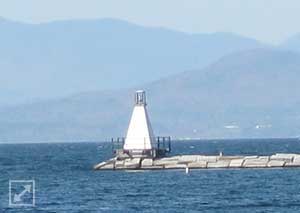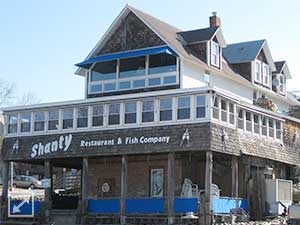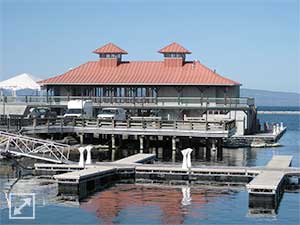Stories & Galleries
Lighthouse Lore
Whenever the lights
watching over Burlington harbor
have been smothered
in early morning mist,
no matter the fuel:
fat, kerosene, or electric battery,
no matter the decade:
1840’s lumber boom, 1890’s lumber decline,
1950’s oil, or 1970’s wasteland,
no matter the keeper:
old timer seaman James Wakefield, community volunteers,
families of Juniper Island, or the automatic switch in a black box,
no matter the sounds:
sawing of boards, whistles of trains,
honks of barges, or laughs of vacationers,
no matter the rain or shine,
the light is only absent for a time,
because every evening before the sun
melts into an orange pool across the sky,
the light will flicker on again,
whether yellow or red,
and it will continue its nightly watch
over our harbor,
lulling us to sleep,
reminding us that
our community wishes safe arrival
for all those
coming from afar.
—Aaron Witham
Evolution of Burlington on the Waterfront
Part 4: Lighthouse Lore
Before 1938, residents went out every night to light the lights (18). The Federal government hired a local farmer to be the caretaker in 1856, but by 1862, it was taken over by various residents. Most of them didn’t last more than a year, except for two men who took care of it the longest. One was Edgar Chiott, who took care of it for 30 years, and the other was James Wakefield, who took care of it for 18½ years. James Wakefield was a very interesting man (18).
Wakefield gave up a career on the sea in England and moved to the United States in 1857, where he opened a sail loft. (18). He made sails and dealt ship supplies. In 1894, he started leasing the building currently known as the restaurant, Shanty on the Shore (28).
This property was originally owned by Gideon King, one of the earliest and most powerful merchants of Burlington’s old waterfront (Read Ye Olde Water Street for more on him). King then sold the property to Isaac Nye. Nye then built a house on the land in 1833 (25). Nye was a powerful figure as well. He was responsible for building the wharf at King Street (28). But, an old story says that later in life he became quite an odd fellow. He began dressing in all black and stopped leaving the house. The only time he would leave the house would be to follow funeral processions (25). Haunted house writers say that he now haunts the Shanty (25).
When James Wakefield began leasing the Shanty house in 1894, he used it as a place to manufacture yachts, awnings, tents, fixtures, and wagon covers (28). The Shanty Restaurant claims that the pulleys hanging outside the building today are preserved from James Wakefield’s business, as well as the wood beams and lintels over the doors and windows (28). Although the Champlain Transportation Company began using the building as an office in 1913 (28), Wakefield continued his business in another location (18). Even after his death, his sons continued the business until it finally closed in 1967 (18).
In 1874, a house commissioned to an engineering firm mistakenly ended up in Burlington (18). The U.S. war department was in charge of the lake at that time, and decided to donate the house to the lighthouse cause. So, they put it on the breakwater in front of Burlington harbor, as a place where Wakefield could stay while tending the

Lighthouse at the Southern End of the Breakwater where the General Butler Lies (2012) Photo by Aaron Witham
But, Wakefield would become forever a part of the legacy of the waterfront one cold, brutal stormy night in December of 1876 (18). The General Butler, an 1862-class canal schooner was en route to Burlington harbor carrying a cargo of Isle La Motte marble for Burlington Marble Works (5). The Captain, William Montgomery, was acting like the classic merchant of the time, trying to squeeze in a few last shipments before winter took full grip of the harbor. But, traveling late in the season was dangerous, and the storm that night almost proved deadly. The strong wind gusts pushed the boat toward the north end of the breakwater. They avoided striking the rocks there, but then drifted south and Montgomery tried to steer the ship around the southern end of the breakwater. But, he didn’t make it. The ship crashed into the rocks just before the southern lighthouse and immediately begin to sink (5).
The passengers and crew were able to leap onto the breakwater just in time. After Montgomery jumped, a large wave swallowed the final section of the ship and it sunk to the bottom of the lake, where it still sits today as a historic shipwreck (5).
James Wakefield and his son rowed out to the sinking ship to rescue the sailors, while dozens of local sailors and citizens watched from the shore, none of them willing to brave the storm (5, 28). James and his son saved all the passengers and crew. He is honored today in the Burlington Boat House at the bottom of college street, where the second floor public function room is named after him (5).
Despite the horror of shipwrecks and the gritty work that the laborers had to endure through the waterfront’s industrial past, many people still cling to the romantic notion of a vibrant shipping port. It’s an era that is hard to let go of. The first automatic lights were installed in 1938 to replace the traditional light houses (18). The new ones were only metal poles with battery-powered lights (25). The change signified the end of an era. Until then, local citizens had tended the kerosene lamps (5). On the final night before the installation, seventy-five people in a dozen boats shepherded the last light keeper, Rolla W. Hill, to shore where a crowd of citizens watched from Battery Park (5).

